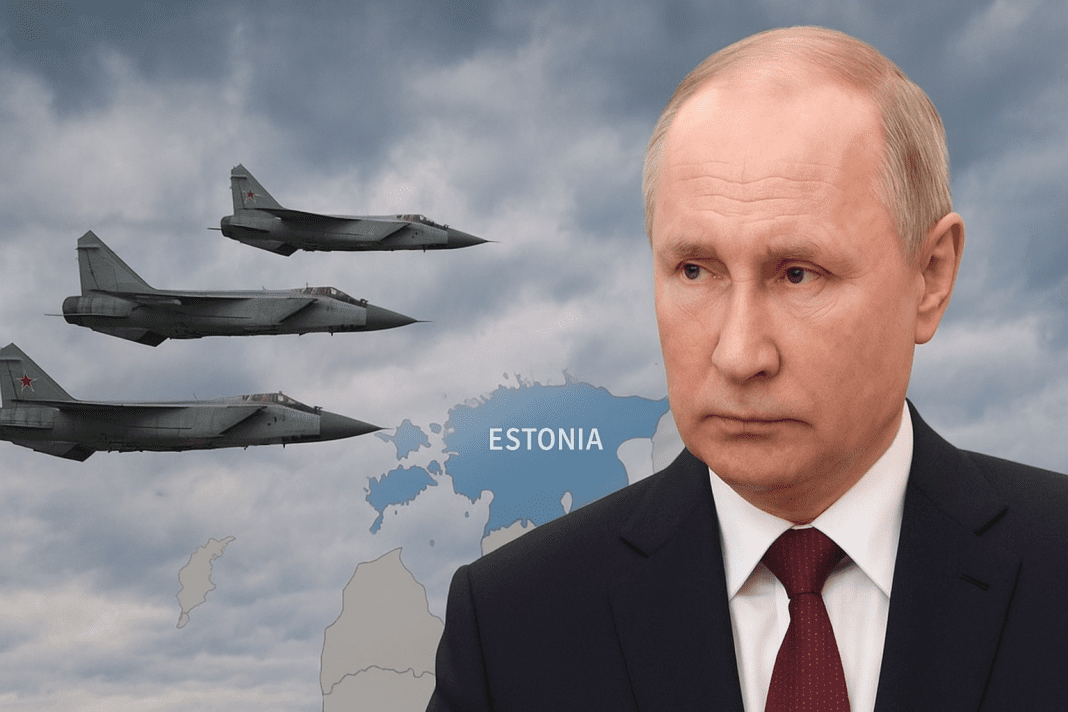Russian President Vladimir Putin has conducted aggressive maneuvers toward NATO countries, raising widespread concern. On Friday, three Russian MiG-31 fighter jets entered Estonian airspace without filing flight plans and with their transponders turned off. These aircraft did not respond to air traffic control and loitered over Estonian territory for a full 12 minutes.
Putin’s Airspace Breaches Raise Alarm
This is the fourth time in 2025 that Russia, under Putin’s command, has violated Estonian airspace. Estonia, a NATO member since 2004, has faced repeated provocations from Moscow, demonstrating a pattern of testing NATO’s defensive resolve. Analysts note that while accidental airspace breaches can occur, the deliberate nature of these flights, combined with disabled transponders and non-responsiveness, signals an intentional act of provocation orchestrated by Putin.
The latest incursion follows a prior incident in Poland, where Russian drones entered NATO territory without facing consequences. Experts argue that the lack of response emboldens Putin to escalate further, using military maneuvers as a form of political signaling.
Why Poland’s shootdowns matter: first on-territory intercepts raise Article 5 questions
Historical Precedents Show the Stakes for Putin
Historical incidents highlight how NATO members have previously responded to similar provocations. Nearly a decade ago, Turkey confronted Russia when a Russian Su-24 fighter violated its airspace over Syria. On November 24, 2015, Turkey shot down the jet after repeated warnings, demonstrating a firm commitment to defending its territory.
Turkey’s actions illustrated that decisive measures can reinforce deterrence. While Russia, under Putin, imposed sanctions on Ankara and issued strong public statements, NATO largely backed Turkey, showing solidarity among allies. The event did not trigger a broader military conflict, but it clearly communicated that violations of territorial integrity would have serious consequences for Putin’s actions.
Mysterious Drones Breach U.S. Military Base for 17 Days
This precedent is now particularly relevant as NATO faces repeated Russian tests. Analysts point to President Donald Trump’s summit with Putin, which some observers say may have signaled leniency, encouraging Putin to push boundaries without immediate repercussions.
Rising Tensions Demand Clear Red Lines Against Putin
The repeated incursions by Russian military aircraft indicate a broader strategy under Putin to weaken NATO’s mutual defense guarantees. NATO experts emphasize that such provocations are designed to test the alliance’s readiness and resolve. Each unchallenged violation creates a perception that Putin faces minimal risk.
Military analysts note that decisive responses can prevent escalation. Turkey’s actions in 2015 are cited as a model for handling reckless military maneuvers. In that case, Russia’s aircraft were met with direct consequences, signaling to Putin that violations would incur a price. NATO members emphasize that consistency in enforcing red lines is essential to maintaining the credibility of collective defense agreements.
In recent weeks, the escalation has taken a more concerning turn. Russia’s MiG-31 jets, following Putin’s orders, operated without flight plans and avoided communication, a tactic that experts describe as both provocative and unsafe. NATO air forces have intercepted these flights, conducting defensive maneuvers to ensure national airspace is protected.
Observers also point out that the airspace violations occur amid ongoing conflicts in Ukraine. While the situation on the ground in Ukraine remains tense, the actions of the Russian military under Putin demonstrate a willingness to challenge international norms. NATO officials stress that vigilance is critical, and repeated violations cannot go unaddressed if the alliance is to maintain credibility.
Russia Caught Off Guard as Ukraine’s ‘Spider’s Web’ Cripples Air Fleet
Military and diplomatic experts highlight that clear messaging and coordinated action among NATO members are key. Airspace incursions, drone violations, and other aggressive military maneuvers under Putin’s direction are signals that demand an immediate and proportionate response. Historical examples, like Turkey’s response in 2015, reinforce the effectiveness of decisive action in deterring future provocations.
As tensions rise, NATO countries continue to monitor Russian military movements closely. Estonia, along with other NATO members, is emphasizing the importance of communication, coordinated air defense readiness, and strict enforcement of territorial boundaries. These measures aim to prevent further escalation and maintain stability in the region.
